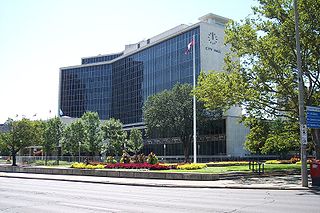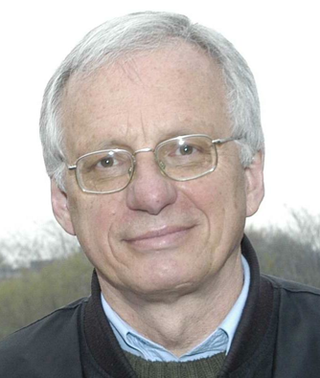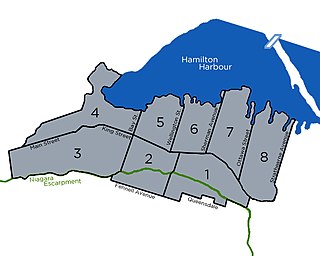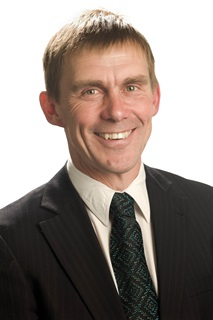
The 1988 Hamilton municipal election was held on November 14, 1988 to elect a Regional Chairman, a Mayor, sixteen members to Hamilton, Ontario City Council, seventeen members to the Hamilton Board of Education and thirteen members to the Hamilton-Wentworth Roman Catholic Separate School Board.

The 1985 Hamilton municipal election was held on November 12, 1985 to elect a Mayor, sixteen members to Hamilton, Ontario City Council, fourteen members to the Hamilton Board of Education and sixteen members to the Hamilton-Wentworth Roman Catholic Separate School Board. In addition, this election was accompanied by a referendum question asking voters if they wanted to directly elect individuals to the office of Regional Chairman.

Politically, Hamilton is known for producing groundbreaking, colourful and left-wing politicians. Locally, though, the big political stories have included the controversial amalgamation of Hamilton with its suburbs in 2001, the destruction of green space around the Red Hill Valley to make way for the Red Hill Creek Expressway, and plans to build a Light Rail Transit line in the city.

The 2010 Hamilton municipal election was held on October 25, 2010, to select one mayor, fifteen members of the Hamilton, Ontario City Council and members of both English and French public and Catholic school boards. Nominations opened January 4, 2010, and ran until September 10, 2010.
The 2000 Hamilton municipal election was a municipal election held on November 13, 2000, to elect municipal officials for the City of Hamilton. On election day, Hamiltonians elected a mayor, 15 city councillors, and trustees for the Hamilton-Wentworth District School Board, Hamilton-Wentworth Catholic District School Board, Conseil scolaire Viamonde, and Conseil scolaire catholique MonAvenir. This was the first election of the "New" City of Hamilton after the dissolution of the Region of Hamilton-Wentworth and the amalgamation of Dundas, Stoney Creek, Flamborough, Ancaster, Glanbrook, and Waterdown with the existing city of Hamilton.
The Labor-Progressive Party was the legal front of the Communist Party of Canada and several provincial wings of the party from 1943 to 1959.

The 1944 Hamilton municipal election was held on December 4, 1944 to select one Mayor, four Controllers, and sixteen members of the Hamilton, Ontario City Council. Voters also elected one member per-ward to the local Public School Board for a two-year term.

The 1946 Hamilton municipal election was held on December 9, 1946, to select one Mayor, four Controllers, and sixteen members of the Hamilton, Ontario City Council, as well as members of the local Board of Education. Held immediately following the 1946 Stelco strike, the election set a record for voter turnout, with 65.1% of eligible voters casting a ballot.

The mayor of Liverpool was the executive mayor of the city of Liverpool in England. The office was abolished in 2023 and its functions were replaced with the leader of Liverpool City Council.

The 2014 Hamilton municipal election was a municipal election that occurred on October 27, 2014, to select one mayor, fifteen members of the Hamilton City Council and members of both English and French Public and Catholic School Boards. As per the Ontario Municipal Elections Act, nominations opened on January 2, 2014, and closed on September 12, 2014. Four new councillors were elected in open seats across Hamilton while all incumbents who stood for re-election had returned to office. Though marked by a steep decline in voter turnout, this election was historic, as it saw the election of Hamiton's first openly gay and first racialized members of city council.

The 1991 Hamilton municipal election was a municipal election held on November 12, 1994, to select one Regional Chairman, one Mayor, two alderman for each of the city's eight wards for a total of sixteen members of the Hamilton, Ontario City Council, and members of both English and French Public and Catholic School Boards. This election marked one of the most stunning turnovers in local history, with four incumbent aldermen being defeated by political newcomers and Ward 3 Alderman Brian Hinkley being soundly defeated in his bid for the mayoralty against incumbent Mayor Bob Morrow.
William Kenneth Warrender was a Canadian politician, who represented Hamilton Centre in the Legislative Assembly of Ontario from 1951 to 1962 as a Progressive Conservative member. Prior to his service in the Legislature, Warrender was a lawyer and civic politician in Hamilton.

The 1932 Hamilton municipal election was held on December 5, 1932 to select one Mayor, four Controllers, and sixteen members of the Hamilton, Ontario City Council, two from each of the city's eight wards. Voters also cast ballots for trustees for the public school board.

The 1933 Hamilton municipal election was held on December 4, 1933 to select one Mayor, four Controllers, and sixteen members of the Hamilton, Ontario City Council, two from each of the city's eight wards. Voters also cast ballots for trustees for the public school board.

The 1934 Hamilton municipal election was held on December 3, 1934, to select one Mayor, four Controllers, and sixteen members of the Hamilton, Ontario City Council, two from each of the city's eight wards. Voters also cast ballots for trustees for the public school board.
The 1930 Hamilton municipal election was held on December 1, 1930 to select one Mayor, four Controllers, and sixteen members of the Hamilton, Ontario, City Council, two from each of the city's eight wards. Voters also cast ballots for trustees for the public school board.

The 1944 Wellington City mayoral election was part of the New Zealand local elections held that same year. In 1944, election were held for the Mayor of Wellington plus other local government positions including fifteen city councillors. The polling was conducted using the standard first-past-the-post electoral method.
The 1927 Hamilton municipal election was held on December 5, 1927 to select one Mayor, one Hydro Commissioner, four Controllers, and sixteen members of the Hamilton, Ontario, City Council, two from each of the city's eight wards. Voters also cast ballots for trustees for the public school board, and in two bylaw referendum questions regarding an expansion to Hamilton's General Hospital and the city's sewer system.

The 2019 Wellington City mayoral election was part of the New Zealand local elections and was be held on 12 October to determine who would serve as Mayor of Wellington for the next three-year term. It was won by Andy Foster, who unseated the incumbent Justin Lester by 62 votes.
The 1935 Hamilton municipal election was held on December 2, 1935 to select one Mayor, four Controllers, and sixteen members of the Hamilton, Ontario, City Council, two from each of the city's eight wards. Voters also cast ballots for trustees for the public school board, and in three plebiscites that sought to restructure elections for both city council and the public school board.








